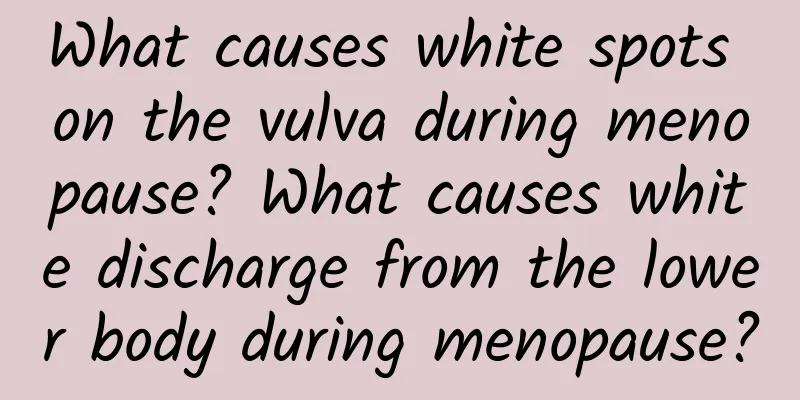What causes white spots on the vulva during menopause? What causes white discharge from the lower body during menopause?

|
Menopause is an important transition period for women both physically and psychologically, usually occurring between the ages of 45 and 55. During menopause, due to the gradual decline of ovarian function, the estrogen level in women changes, which has an important impact on women's health. In addition to common symptoms such as hot flashes, sweating, mood swings, etc., some women may also experience symptoms such as vulvar leukoplakia and white discharge during menopause, which has caused concern and confusion among many women. There are many reasons for white spots on the vulva during menopause, the most common of which is chloasma. Chloasma is caused by decreased estrogen levels, skin aging, ultraviolet radiation, and some genetic factors. In addition, some diseases such as vitiligo, leukoplakia and other skin diseases may also cause white spots on the vulva. Therefore, if white spots appear on the vulva during menopause, you should seek medical attention in time to rule out the possibility of other diseases. In addition, white discharge from the lower body during menopause is also a common problem. During menopause, due to the decline in estrogen levels, the secretion function of vaginal mucosal cells will also change, causing vaginal discharge to become scarce and white. Although this white discharge is normal, if there are abnormal conditions such as fishy odor, itching or odor, it may be vaginal inflammation caused by bacterial infection, and you need to seek medical treatment in time. To maintain the health of the vulva during menopause, first pay attention to personal hygiene and keep the vulva dry and clean. Choose the right underwear material and avoid underwear that is too tight, which will help reduce bacterial growth. In addition, maintaining a balanced diet and healthy lifestyle habits will help relieve menopausal discomfort. In summary, the cause of white spots on the vulva during menopause may be chloasma, secondary skin diseases and other factors. White discharge from the lower body during menopause is normal, but you need to be alert to infection. Correctly understanding and treating these problems will help women better go through menopause. If the above symptoms occur, it is recommended to see a doctor as soon as possible for timely diagnosis and treatment. Menopause is a physiological transition period for women, usually occurring between the ages of 45 and 55. During menopause, the estrogen level in women gradually decreases, and ovarian function declines, causing a series of physical and psychological changes. Common symptoms of menopause include hot flashes, sweating, and mood swings. In addition, some women may experience symptoms such as vulvar leukoplakia and white discharge during menopause. Vulvar leukoplakia may be caused by skin problems such as melasma. White discharge is normal, but odor or itching should be paid attention to. Maintaining personal hygiene and a balanced diet can help relieve the discomfort of menopause. If related symptoms occur, seek medical attention in time for diagnosis and treatment. |
Recommend
Women should know the symptoms of hyperprolactinemia early
Women should know the symptoms of hyperprolactine...
Diagnostic criteria for pelvic peritonitis
Our lives are getting better, but there are still...
Can women with chronic cervicitis eat brown sugar? Three dietary care principles for patients with chronic cervicitis
Patients with chronic cervicitis should choose th...
What are the symptoms of bacterial vaginosis?
What are the characteristics of bacterial vaginit...
Happy fat! Survey: 60% of adults gain weight when in love
Taiwanese female artist Xiao Tiantian lost 20 kil...
How to prevent ovulation bleeding
Some women report that they often bleed after men...
How to prevent adnexitis?
Women are most painful when they suffer from gyne...
How to cure menopause quickly
Women will experience menopause at a certain age....
What are the precautions after spontaneous abortion? Pay special attention to it
After a miscarriage, the first thing to do is to ...
How much does it cost for women to undergo endometrial tuberculosis surgery?
How much does the surgery for endometrial tubercu...
What are the symptoms of female menopausal syndrome
Female menopausal syndrome usually refers to peri...
Causes of ovarian cysts
What are the causes of ovarian cysts? Ovarian cys...
What are the dangers of ovarian chocolate cyst rupture? Is it more dangerous than not ruptured?
I believe that everyone is familiar with ovarian ...
How to treat bleeding from cervicitis in women? Try 5 methods to treat bleeding from cervicitis in women
If a woman suffers from cervicitis or cervical er...
What are the specific methods for checking vulvar leukoplakia?
Do you know how to check for vulvar leukoplakia? ...









